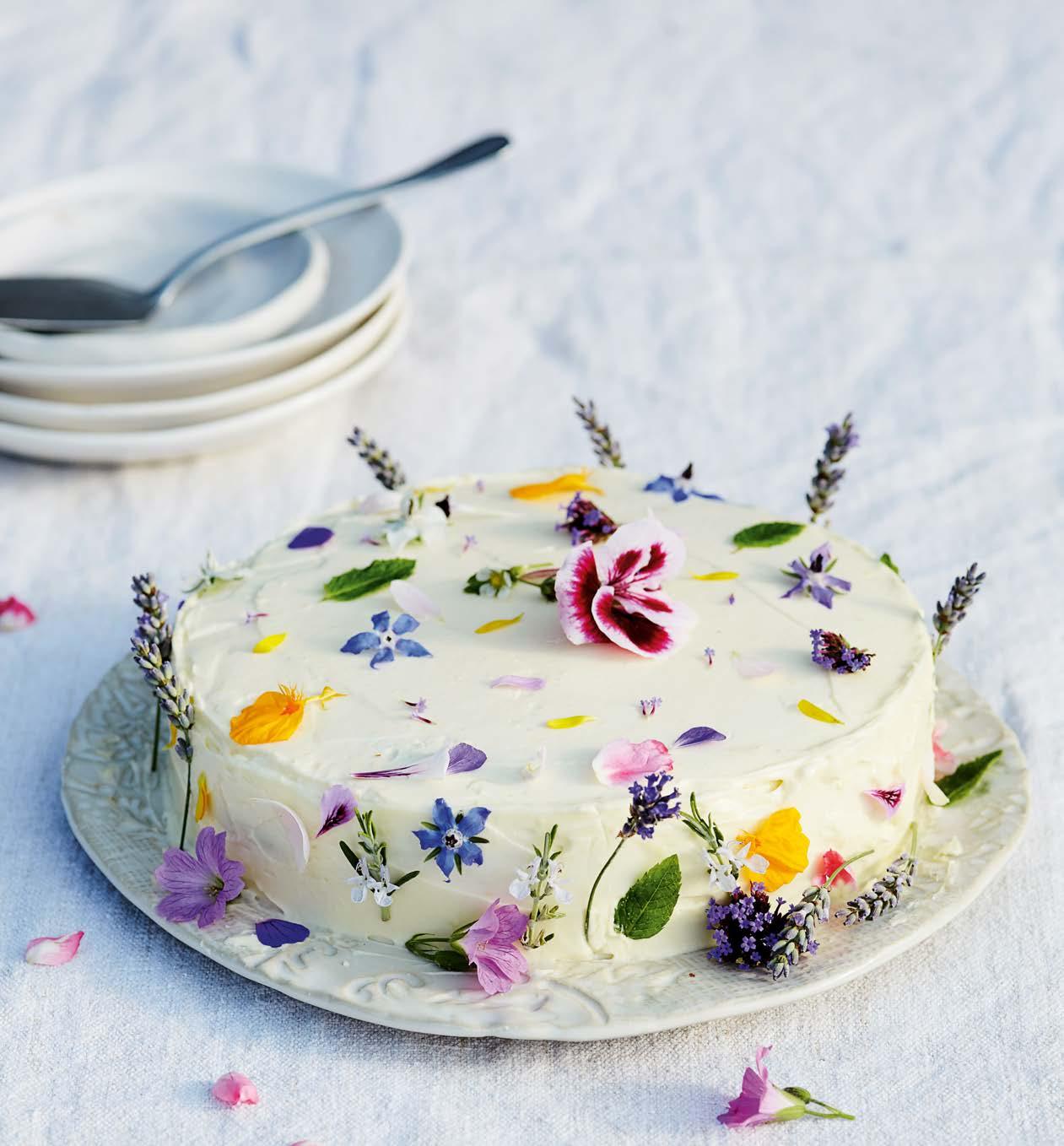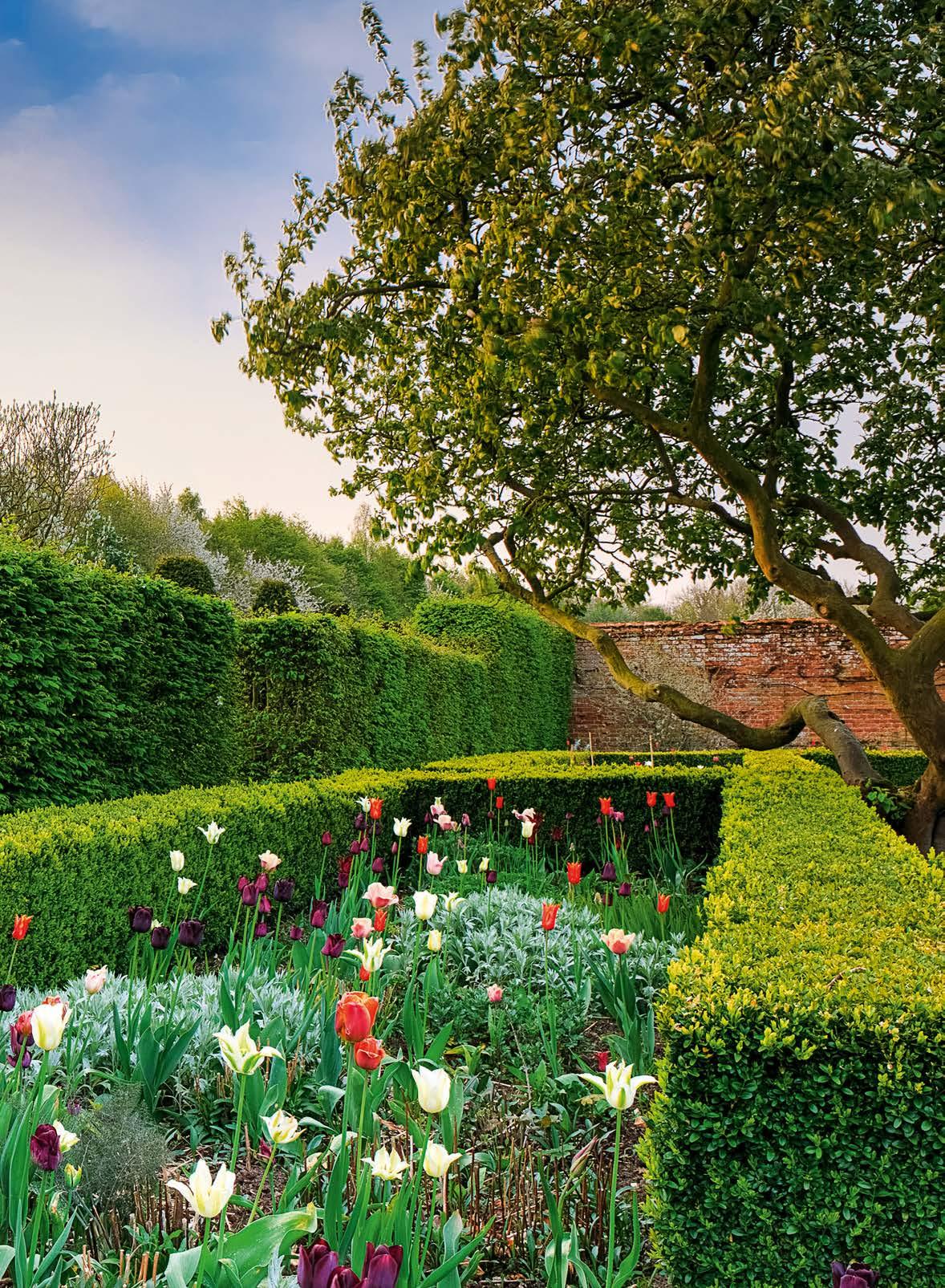
13 minute read
Holme Hale Hall The former kitchen
This image Tulips and silvery artemisia in the walled garden. Opposite Arches of trained apples covered in blossom lead to a snail-shell fountain by Thomason Cudworth.
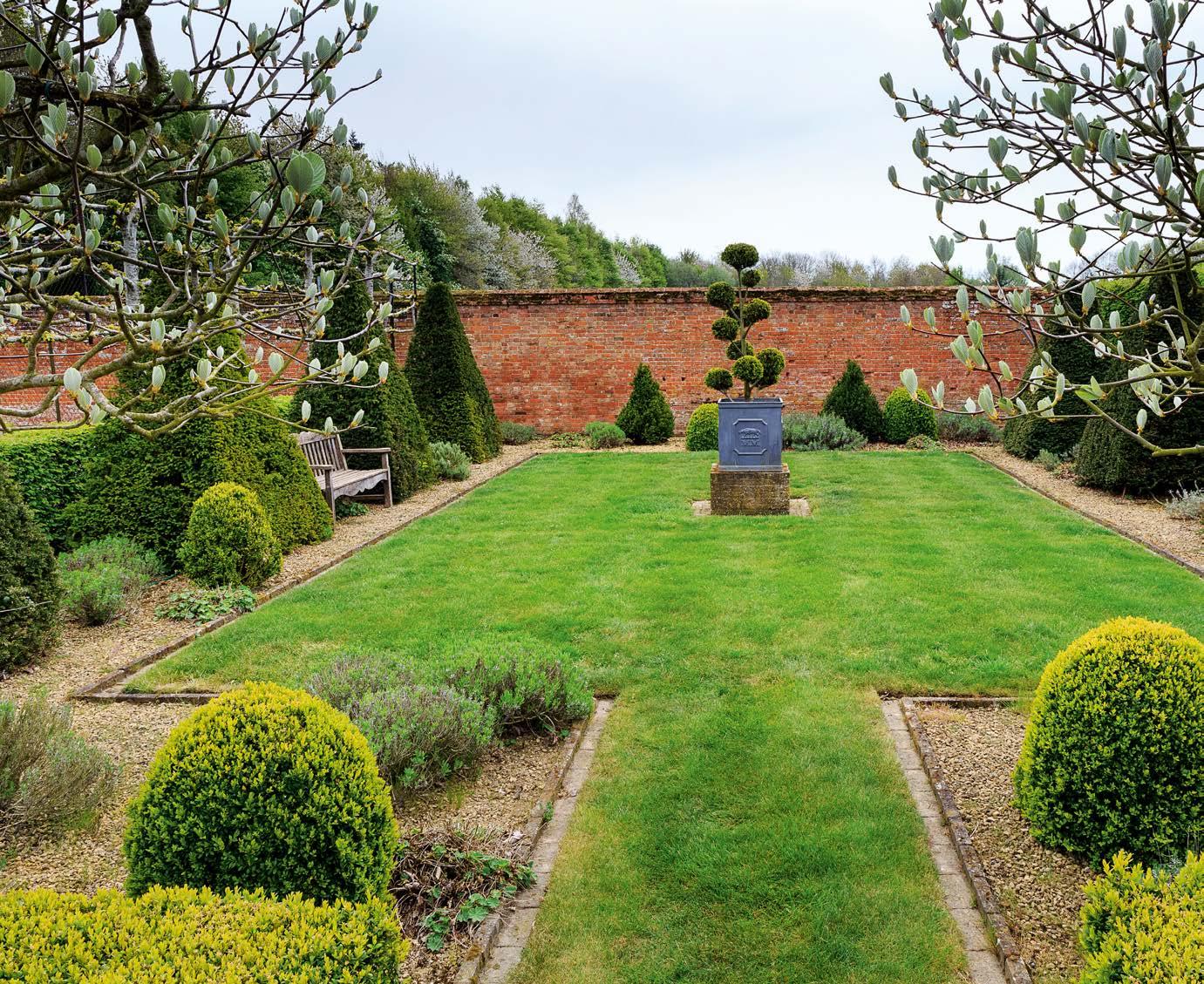
From a 130-year-old wisteria to a kitchen garden replanted in 2016, Holme Hale Hall in Norfolk spans the centuries with its mix of established trees and shrubs and new plantings of perennials and bulbs. As the spring sun rises, the early sunlight filters through surrounding trees, across the southfacing house and into the walled garden, warming its weathered brickwork. The coppery tones of beech, Fagus sylvatica (Atropurpurea Group) contrast with the creamy Tulipa ‘Spring Green’ and fresh shoots of perennial honesty, Lunaria rediviva, while the lilac hue of the venerable wisteria (W. sinensis) is echoed by tulips on the terrace. Everywhere there is a sense of ancient presence alongside new life.
This is Holme Hale Hall, home to the Broke family for generations. “It was created in its current form at the turn of the 19th century,” says Simon Broke. “The owner, Robert Farrand, studied
Above In this quiet garden, cloud-pruned box is the focal point, with yew pyramids and box balls creating a contemplative space. architecture in Florence and when he returned, he turned what had been a fairly simple Elizabethan farmhouse into an Italianate villa. He also attached the kitchen garden to the house, which is a very rare feature. Most kitchen gardens are 200 yards away, because Victorian ladies didn’t want to see, hear or smell anything concerning the garden!”
Simon’s great-grandfather bought the house in 1867, and Simon and his wife Delia took up the reins from Simon’s parents in 1985. With her gardening background, Delia realised that she wanted to “do something” with the outside space, but with two young sons, priorities were conflicting. “We had a bed of asparagus, and some raspberries, otherwise it was mostly used as a football pitch, or for cricket, or pitch and putt,” Simon recalls, laughing.
Enter renowned garden designer Arne Maynard. “There was a tiny article in one of the Sunday magazines,” Delia remembers. “It spoke of a person
Top Tulip ‘Paul Scherer’ with pink ‘Barcelona’ and ‘Aveyron’ in large pots. Top right Holme Hale Hall’s owners, Simon and Delia Broke, in the shade of an old quince tree. Middle A Japanese cherry in full, glorious bloom, frames the house. Bottom Chris Marchand, Holme Hale Hall’s full-time gardener. named Arne Maynard who enjoyed renovating kitchen gardens. I knew nothing about him, but I had a rush of blood to the head, sent him a picture of the garden, which was in a terrible state, and asked would he ever be interested to come and look? And he came!” This was November 1999, and by the spring of 2000 the first planting was completed. “We were up to our knees in mud in February,” Delia recalls. “Later that same year, Arne and Piet Oudolf won Best Show Garden at Chelsea.”
Before putting pen to paper, Arne set about discovering the personality of the family: likes and dislikes and how they lived their lives. The football pitch was shifted out of the walled part of the garden, and formal structures – clipped yew (Taxus baccata), pleached lime (Tilia x europaea) and whitebeam (Sorbus aria ‘Lutescens’), along with hornbeam hedging (Carpinus betulus) – were installed to create distinct areas and conceal the swimming pool and tennis court. The formality, says Delia, reflects her upbringing, while the free-form, meadow-style planting in the borders is indicative of her creative side – she paints in her spare time.
Full-time gardener Chris Marchand joined the team in 2016 to undertake the second wave of planting. This replaced the original scheme, which had focused on cut flowers, with a more balanced mixture of perennials and shrubs. He and Delia now work together to manage not just the appearance of the garden but also its ecosystem.
“We are trying to be more conscious of our environment,” Chris explains. “The aim is to have a beautiful garden full of flowers all year round, which is perfect for pollinating insects and also pest predators. I’ve watched ladybirds completely annihilate a population of aphids on the fruit tree arches, which previously I might have sprayed.”
Out in the parkland, spring bulbs and early native wildflowers, including camassias (Camassia leichtlinii) and cowslips (Primula veris), are now actively managed to naturalise and proliferate. “Establishing the yellow rattle (Rhinanthus minor), which is parasitic on grass, was essential,” says Chris. He also cuts the grass very short early on



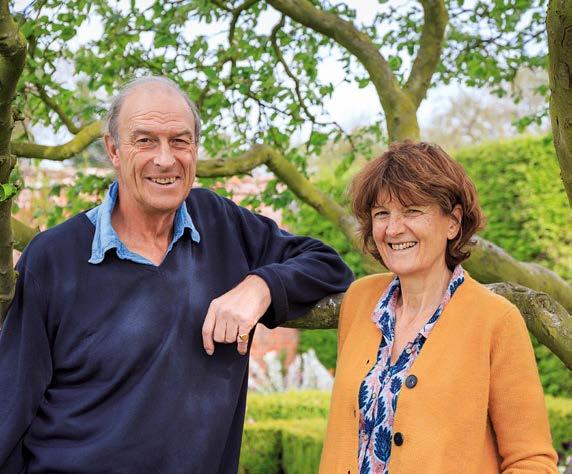
Tulip FEVER
An excellent selection of reliable and high-performing tulips from Holme Hale Hall

‘LASTING LOVE’
This is a lovely lily-flowered variety, with deep red petals and darker tones. It flowers during April and May.

One of the classic choices for dark, dramatic blooms, with goblet-shaped flowers appearing from April to May.
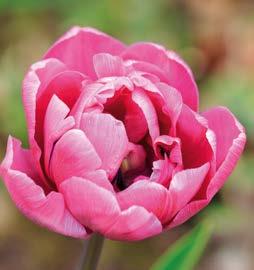
An early-flowering double, producing these sumptuous, almost peony-like pink blooms from March to April.

Starting out purple and fading to lavender and mauve, this robust variety blooms from April to May.

Brilliant for injecting a border with bright, vivid orange, when it bears its elegant flowers from April to May.

The freshest flowers with ivory petals streaked with green on the outside. Blooms will appear from April to May. Above The wonderfully to let the wildflowers early-flowering rambling emerge, and removes the rose, Rosa banksiae ‘Lutea’, is a classic choice for a sheltered wall. clippings after cutting to deplete nutrients, allowing the flowers to hold their own against hungry competitors.
Some aspects of the garden remain unchanged, most notably an early-flowering Banksia rose (Rosa banksiae ‘Lutea’) planted by Simon’s grandmother, and the spectacular wisteria that covers the south face of the house. This was planted some time around 1890, and tradition demands that it is pruned by the male head of household. Simon prunes twice each year, once just after flowering and again at the end of summer, to keep it in bounds.
The wisteria has become the inspiration for the spring colour scheme, which has a soft pastel feel. Now fully garden-addicted, Delia liaises closely with Arne and Chris on any changes to the planting. “It is a beautifully restrained scheme,” she says, “based on complementary colours: mauve and purple against cream and yellow. Our mission is to retain the original scheme, and whenever we have considered changes these have always been done in consultation with Arne. Within that, I tend to go with the sort of palette of colours I use when I paint, but with thought given to the context, so in this case it means keeping in tune with the wisteria.”
Tulips feature in pots close to the house, elegant triumph types teaming with blowsy, peony-flowered varieties, including dark and handsome ‘Paul Scherer’ and sumptuous ‘Blue Diamond’. In the walled garden, the colour scheme is expanded with graceful lily-flowered ‘Spring Green’ and ‘Sarah Raven’ in contrasting tones of cream and dark purple, with an occasional pop of colour delivered by the ever-popular ‘Ballerina’.
Adding a more permanent dimension to the planting, long-established trees, including flowering

This image Mounds of perennial honesty and ‘Spring Green’ tulips give this curving border a fresh look. Below right The facade of the house, adorned with its graceful, 130-year-old wisteria. Below left Magnolia kobus from Japan.
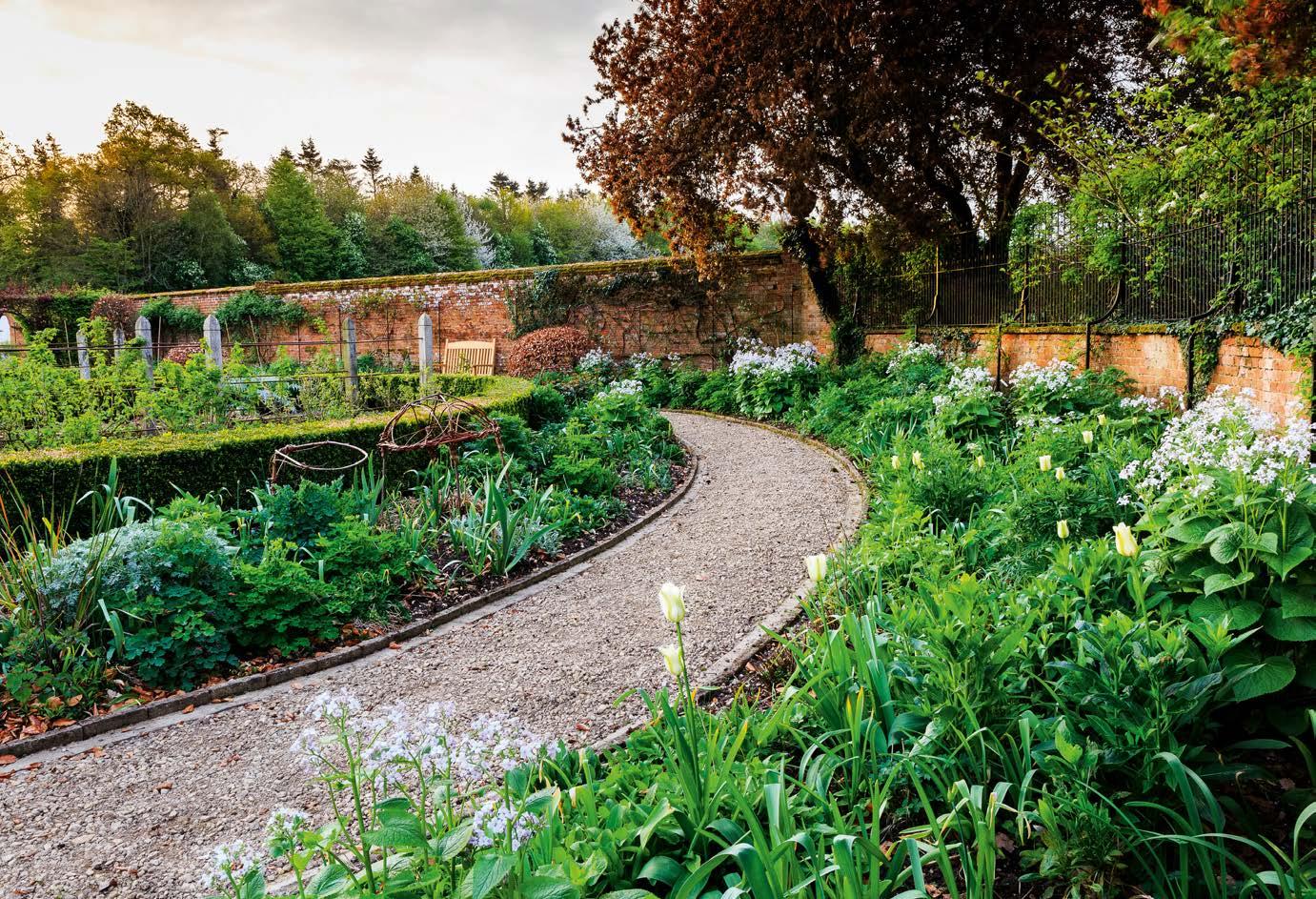


This image The 1890planted Wisteria sinensis, dripping with its pendent purple flowers. Top right A view of the greenhouse, flanked by apple arches and box. Right Gnarled boughs of an old quince, with its large white blooms.
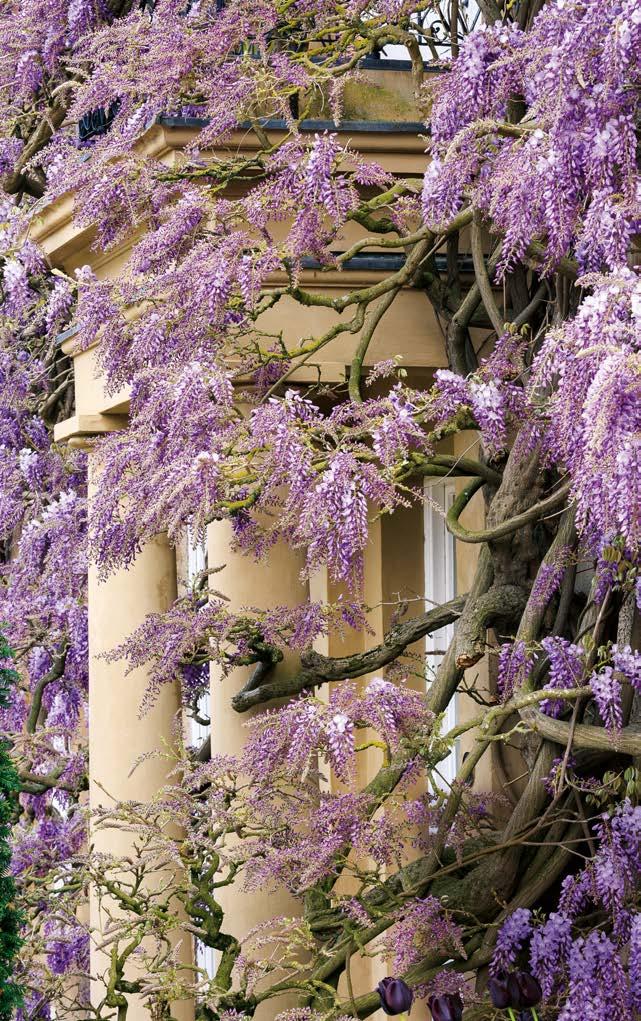
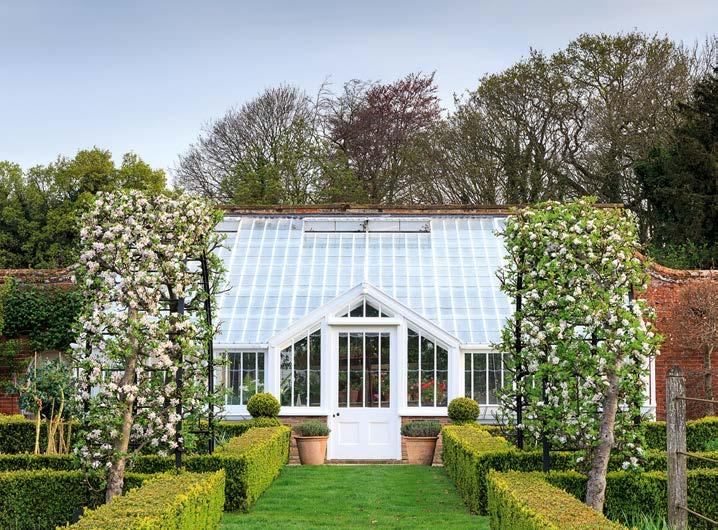
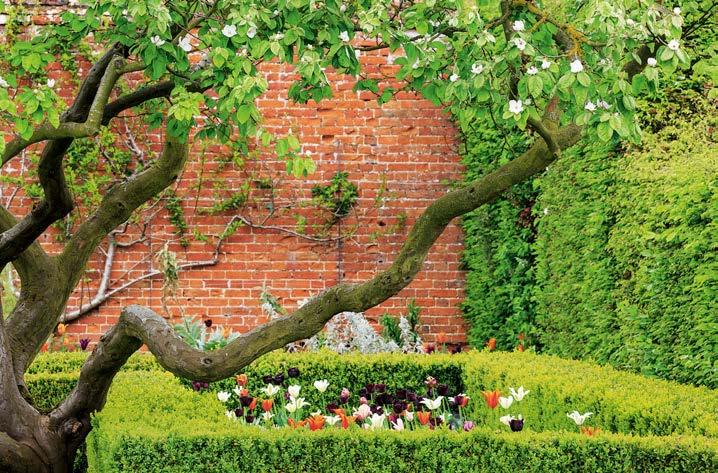
cherry (prunus species) and Magnolia kobus, have been joined by blossom trees in the walled garden: an apple arbour provides flowers in spring, followed by an abundance of eating, while archways of intermingling fresh green hornbeam and flowering crab apples create a tapestry of interwoven foliage and blossom at this time of year.
For Simon, the garden remains important for its social aspect. “It’s very nice to be able to share what we have created with other people,” he says. “We normally hold two open days for charity [despite the pandemic they still managed two pre-booked days last year], and several group visits each year. It’s really fun to share what we’ve done here with them. We all appreciate what the garden is about and hopefully we all learn something from it as well.” n
Holme Hale Hall, Swaffham, Norfolk IP25 7ED opens for the National Garden Scheme on Sunday 27 June and Sunday 5 September, 12-4pm. Visits can be pre-booked online, although this currently isn’t essential. See ngs.org.uk for updates on opening and further visitor information.
PLANTING Tulip Pots
Chris Marchand shares the tips and tricks he uses when planting tulips for container displays
A ‘bulb lasagne’ is the technique Chris uses when potting up tulips. “We layer the bulbs,” he explains. “Rather than aiming for a succession of flowering we want them all to bloom at the same time, so the earlier-flowering cultivars go in deepest, with the mid-flowering varieties in the middle and the later-flowering ones on top. That way they catch each other up and all flower more or less together. Once the flowers have faded, the tulips are replaced with our summer display.” Chris uses SylvaGrow peat-free compost, which is endorsed by the RHS, with some John Innes No. 2 mix added for additional nutrients.
Watering is done as needed, in line with the weather. As the pots are against the south facade of the house this is usually quite frequent. Tulip cultivars to try according to Chris, include: triumph-type ‘Paul Scherer’; peony-flowered ‘Blue Diamond’ and ‘Chato’; flamboyant ‘Cerise Parrot’; ‘Spring Green’; and lily-flowered ‘Ballerina’ and ‘Green Star’.
Paul’s walking no longer an uphill battle thanks to TURMERIC+
Walking is one of the most benefi cial forms of exercise, and also one of the most underestimated in terms of well-being. It’s a great way to reach the recommended level of physical activity needed to stay healthy without the toll to joints, ligaments and muscles that more demanding sports exact.

When taking longer walks however, some of us can experience skeletal and muscular discomfort. Paul Goddard, 62, a Nordic Walking instructor from Saffron Walden in Essex, swears by a product called Turmeric+ as an effective means of keeping him active. “I decided to become a Nordic Walking instructor in 2009 and started walking forty to fi fty miles a week. Two years ago it became uncomfortable to walk distances that should have been easy for someone of my age and fi tness levels. I felt very apprehensive as walking is not only my passion, but my business.” Paul continues: “I started doing some research. I learned that turmeric could be helpful and bought supplements … and then stumbled upon Turmeric+.”
Curcumin, the active ingredient in turmeric, is diffi cult for the body to absorb. Some turmeric products offer high levels of curcumin but unless this is easily absorbed by the body, the higher amounts make little difference.
The need for easy absorption is what led the scientists at FutureYou Cambridge to create Turmeric+ using the patented ‘Curcuma Phospholipid Complex’ formulation. It’s thirty times more absorbable than standard turmeric and contains vitamin C, which contributes to normal collagen formation for the normal function of cartilage.
“Soon after taking it I experienced that ‘light-bulb’ moment - I realised my knees felt like they used to. I take Turmeric+ religiously now. I walk around two hundred miles a month and even my customers have remarked on my mobility. “Walking is great for fi tness as well as your mental health. Being able to walk easily has made a huge difference to my life and I feel fi tter now than I did twenty years ago.”
Adam Cleevely, CEO of FutureYou Cambridge comments:
“We want to support more people to get active and we think Turmeric+ can play an important role in that journey. We have tens of thousands of happy Turmeric+ subscribers who regularly tell us about their positive stories, just like Paul.”
Try Turmeric+ before you buy it
CLAIM YOUR FREE SUBSCRIPTION TRIAL TODAY
Just pay £1.50 postage*
FutureYou Cambridge, the nutraceutical company known for its science-backed health supplements, is offering new customers the chance to try its fl agship product, Turmeric+, for just the cost of the £1.50 postage.* Turmeric+ was developed in Cambridge with the backing of a scientifi c advisory board including luminaries such as Dr Nicholas Shenker, a leading rheumatologist and chronic pain expert at Cambridge University Hospitals NHS Foundation Trust (Addenbrooke’s). The formulation is thirty times more absorbable than standard turmeric, and also contains vitamin C which contributes to normal collagen formation for the normal function of cartilage. Since launching the product the company has continually received positive feedback from happy customers, particularly on Trustpilot, the independent online review platform. ‘As far as I’m concerned this stuff is magic... Highly recommend!’ wrote one 5 star reviewer. ‘The product appears to meet all its promises and the service levels from FutureYou are fi rst class,’ said another. ‘We’re very happy to give people their fi rst pack for free so they can experience it for themselves,’ says Adam Cleevely, the company’s CEO. ‘It might sound bonkers but it really isn’t. We’re that confi dent in the effectiveness of our formulation. ‘I can’t think of a better way to convince people. If they like it, they will stick with it. Tens of thousands of customers already do.’
To claim your free 28 day Turmeric+ subscription trial pack worth £16.80, visit FutureYouOffers.co.uk or freephone 0800 808 5740 quoting code TF54
If it’s not for you, simply cancel your subscription at any time, without obligation.
Discount valid until 31st March 2021. Turmeric+ contains vitamin C which contributes to normal collagen formation for the normal function of cartilage and bones. New UK customers only. One free trial per household. Your fi rst box is free (Just pay £1.50 postage) and you will be enrolled into a fl exible subscription (£16.80 every 28 days). We regret but we cannot take payment for this offer and you will be enrolled into a fl exible subscription (£16.80 every 28 days). We regret but we cannot take payment for this offer by cheque. You can stop deliveries at any time without obligation. See website for more information on our subscription service. by cheque. You can stop deliveries at any time without obligation. See website for more information on our subscription service. Turmeric+ from FutureYou Cambridge should be consumed as part of a healthy and balanced diet and lifestyle. If you are taking Turmeric+ from FutureYou Cambridge should be consumed as part of a healthy and balanced diet and lifestyle. If you are taking any prescribed medication or have any medical conditions always consult your doctor or pharmacist before taking vitamins or any prescribed medication or have any medical conditions always consult your doctor or pharmacist before taking vitamins or supplements. Trial pack promotion cannot be used in conjunction with any other promotions. supplements. Trial pack promotion cannot be used in conjunction with any other promotions.
In spring, Prunus ‘Royal Burgundy’ trees are a highlight of Matthew Spriggs’ garden in Petworth.
Going DUTCH
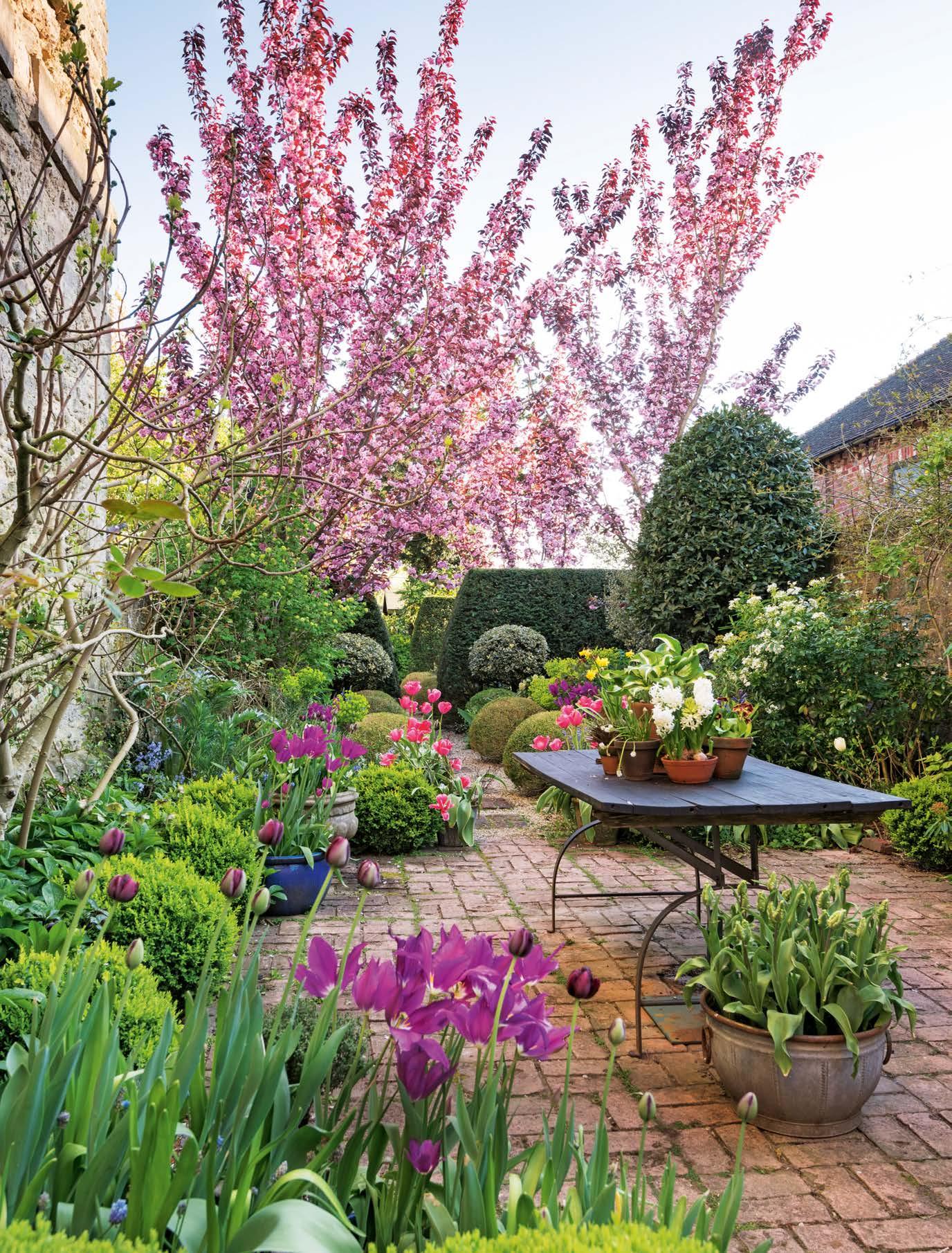
Florist Matthew Spriggs has applied the formality and containment of gardens seen on buying trips to the Netherlands to his narrow garden at Lancaster House in Sussex, with triumphant results and lots of bold tulips




